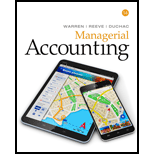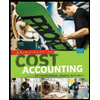
Concept explainers
Activity-based and department rate product costing and product cost distortions
Black and Blue Sports Inc. manufactures two products: snowboards and skis. The factory

The activity base associated with the two production departments is direct labor hours. The indirect labor can be assigned to two different activities as follows:

Instructions
Determine the factory overhead rates under the multiple production department rate method. Assume that indirect labor is associated with the production departments, so that the total factory overhead is $315,000 and $540,000 for the Cutting and Finishing departments, respectively.
Determine the total and per-unit
Determine the activity rates, assuming that the indirect labor is associated with activities rather than with the production departments.
Determine the total and per-unit cost assigned to each product under activity-based costing.
Explain the difference in the per-unit overhead allocated to each product under the multiple production department factory overhead rate and activity-based costing methods.
1.
Compute the multiple production department overhead rates for both departments.
Explanation of Solution
Multiple production department factory overhead rates: This allocation method identifies different departments in the process of production. The factory overheads are allocated to products based on the overhead rate for each of the production departments.
Formula to compute multiple production department overhead rates:
Activity-based costing (ABC) method: The costing method which allocates overheads to the products based on factory overhead rate for each activity or cost object, according to the cost pooled for the cost drivers (allocation base).
Formula to compute activity-based overhead rate:
Compute multiple production department overhead rate for cutting department.
Compute multiple production department overhead rate for finishing department.
2.
Compute the factory overhead allocated to total and per unit of each product.
Explanation of Solution
Compute total factory overhead and per unit overhead allocated for snowboards.
| Production Department | Multiple Production Department Overhead Rate | × | Total Number of Budgeted DLH | = | Factory Overhead |
| Cutting | $52.50 per DLH | × | 4,000 DLH | = | $210,000 |
| Finishing | $90 per DLH | × | 2,000 DLH | = | 180,000 |
| Total factory overhead costs allocated for snowboards | $390,000 | ||||
| Number of units of snowboards | ÷ 6,000 units | ||||
| Factory overhead cost per unit of snowboard | $65.00 | ||||
Table (1)
Note: Refer to part (A) for value and computation of multiple production department overhead rate.
Compute total factory overhead and per unit overhead allocated for skis.
| Production Department | Multiple Production Department Overhead Rate | × | Total Number of Budgeted DLH | = | Factory Overhead |
| Cutting | $52.50 per DLH | × | 2,000 DLH | = | $105,000 |
| Finishing | $90 per DLH | × | 4,000 DLH | = | 360,000 |
| Total factory overhead costs allocated for skis | $465,000 | ||||
| Number of units of skis | ÷ 6,000 units | ||||
| Factory overhead cost per unit of ski | $77.50 | ||||
Table (2)
Note: Refer to part (A) for value and computation of multiple production department overhead rate.
3.
Calculate the activity-based overhead rate for each of the given activities
Explanation of Solution
Compute activity-based overhead rates.
| Computation of Activity-Based Overhead Rates | |||||
| Activity | Activity Cost | ÷ | Total Activity-Base Usage | = | Activity-Based Overhead Rates |
| Production control | $237,000 | ÷ | 500 production runs | = | $474 per run |
| Materials handling | 270,000 | ÷ | 7,500 moves | = | $36 per move |
| Cutting | 156,000 | ÷ | 6,000 DLH | = | $26 per DLH |
| Finishing | 192,000 | ÷ | 6,000 DLH | = | $32 per DLH |
Table (3)
4.
Calculate the activity-cost per unit of the products
Explanation of Solution
Compute activity cost allocated per unit of snowboards.
| Activity | Activity-Based Overhead Rates | × | Actual Use of Activity-Base (Cost Driver) | = | Activity Cost Allocated |
| Production control | $474 per run | × | 430 runs | = | $203,820 |
| Materials handling | 36 per move | × | 5,000 moves | = | 180,000 |
| Cutting | 26 per DLH | × | 4,000 DLH | = | 104,000 |
| Finishing | 32 per DLH | × | 2,000 DLH | = | 64,000 |
| Total activity costs allocated to snowboards | $551,820 | ||||
| Number of units of snowboard | ÷ 6,000 units | ||||
| Activity-based overhead cost per unit of snowboards | $91.97 | ||||
Table (4)
Note: Refer to Table (3) for the value and computation of activity allocation rates.
Compute activity cost allocated per unit of snowboards.
| Activity | Activity-Based Overhead Rates | × | Actual Use of Activity-Base (Cost Driver) | = | Activity Cost Allocated |
| Production control | $474 per run | × | 70 runs | = | $33,180 |
| Materials handling | 36 per move | × | 2,500 moves | = | 90,000 |
| Cutting | 26 per DLH | × | 2,000 DLH | = | 52,000 |
| Finishing | 32 per DLH | × | 4,000 DLH | = | 128,000 |
| Total activity costs allocated to skis | $303,180 | ||||
| Number of units of skis | ÷ 6,000 units | ||||
| Activity-based overhead cost per unit of ski | $50.53 | ||||
Table (5)
Note: Refer to Table (3) for the value and computation of activity allocation rates.
5.
Discuss the product cost distortion due to multiple production department overhead rate
Explanation of Solution
The product cost under multiple production department overhead rate approach and ABC approach are different. The product cost is distorted in multiple production department overhead rate approach. Although the time spent for cutting and finishing for snowboards and skis is in the same ratio, but the production control department and materials handling department are not accounted for in multiple department overhead rate method.
Want to see more full solutions like this?
Chapter 4 Solutions
Bundle: Managerial Accounting, 14th + Cengagenowv2, 1 Term Printed Access Card
- I need help finding the accurate solution to this financial accounting problem with valid methods.arrow_forwardAurora Biotechnology sells on credit terms of net 30. Its accounts are, on average, 8 days past due. Annual credit sales are $4.6 million. What is the company's balance sheet amount in accounts receivable?arrow_forwardProvide Answerarrow_forward
- Can you explain this financial accounting question using accurate calculation methods?arrow_forwardComet Industries reported FIFO ending inventory of $138,200 and a beginning inventory of $130,600 for 2023. Inventory purchases for 2023 were $278,500, and the change in the LIFO reserve for 2023 was an increase in the LIFO reserve of $1,050. Calculate the value of COGS under LIFO for Comet Industries in 2023.arrow_forwardWhat is the primary purpose of the trial balance?A) To prepare financial statementsB) To detect errors in journal entriesC) To ensure debits equal creditsD) To calculate net incomestep by steparrow_forward
- I am looking for help with this financial accounting question using proper accounting standards.arrow_forwardPlease give me true answer this financial accounting questionarrow_forwardWhich principle dictates that expenses should be recognized in the same period as the revenues they help to generate?A) Revenue Recognition PrincipleB) Matching PrincipleC) Conservatism PrincipleD) Cost Principlearrow_forward
- Please provide the correct answer to this financial accounting problem using accurate calculations.arrow_forwardI am searching for the accurate solution to this financial accounting problem with the right approach.arrow_forwardWhat is the primary purpose of the trial balance?A) To prepare financial statementsB) To detect errors in journal entriesC) To ensure debits equal creditsD) To calculate net income need help!arrow_forward
 Managerial AccountingAccountingISBN:9781337912020Author:Carl Warren, Ph.d. Cma William B. TaylerPublisher:South-Western College Pub
Managerial AccountingAccountingISBN:9781337912020Author:Carl Warren, Ph.d. Cma William B. TaylerPublisher:South-Western College Pub Financial And Managerial AccountingAccountingISBN:9781337902663Author:WARREN, Carl S.Publisher:Cengage Learning,
Financial And Managerial AccountingAccountingISBN:9781337902663Author:WARREN, Carl S.Publisher:Cengage Learning, Cornerstones of Cost Management (Cornerstones Ser...AccountingISBN:9781305970663Author:Don R. Hansen, Maryanne M. MowenPublisher:Cengage Learning
Cornerstones of Cost Management (Cornerstones Ser...AccountingISBN:9781305970663Author:Don R. Hansen, Maryanne M. MowenPublisher:Cengage Learning- Principles of Accounting Volume 2AccountingISBN:9781947172609Author:OpenStaxPublisher:OpenStax College
 Managerial Accounting: The Cornerstone of Busines...AccountingISBN:9781337115773Author:Maryanne M. Mowen, Don R. Hansen, Dan L. HeitgerPublisher:Cengage Learning
Managerial Accounting: The Cornerstone of Busines...AccountingISBN:9781337115773Author:Maryanne M. Mowen, Don R. Hansen, Dan L. HeitgerPublisher:Cengage Learning Principles of Cost AccountingAccountingISBN:9781305087408Author:Edward J. Vanderbeck, Maria R. MitchellPublisher:Cengage Learning
Principles of Cost AccountingAccountingISBN:9781305087408Author:Edward J. Vanderbeck, Maria R. MitchellPublisher:Cengage Learning





